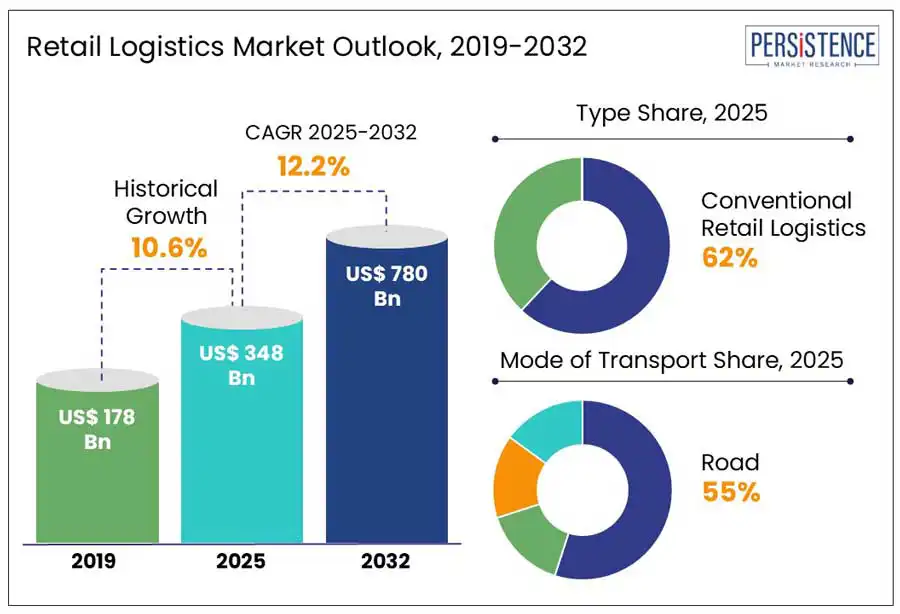Comprehensive Snapshot of Retail Logistics Market Including a Brief of Regional and Country Analysis.
Industry: Consumer Goods
Published Date: April-2025
Format: PPT*, PDF, EXCEL
Delivery Timelines: Contact Sales
Number of Pages: 180
Report ID: PMRREP35193
The global retail logistics market size is anticipated to be valued at US$ 348 Bn in 2025. According to Persistence Market Research, the industry is projected to reach US$ 780 Bn at a CAGR of 12.2% by 2032.
Retail logistics is no longer just a back-end operation but a backbone for enhanced customer experience, brand loyalty, and competitive edge. As same-day deliveries, instant returns, and hyper-personalized shopping have become a norm, the retail industry is experiencing fierce competition. A booming e-commerce industry, increasing adoption of automation in warehouses, sustainable logistics solutions and the expansion of last-mile delivery solutions are factors driving the market growth during the forecast period.

Key Industry Highlights
|
Global Market Attribute |
Key Insights |
|
Retail Logistics Market Size (2025E) |
US$ 348 Bn |
|
Market Value Forecast (2032F) |
US$ 780 Bn |
|
Projected Growth (CAGR 2025 to 2032) |
12.2% |
|
Historical Market Growth (CAGR 2019 to 2024) |
10.6% |
Retail logistics market is undergoing a significant transformation driven by automation technologies aimed at boosting operational efficiency and profitability. Automated warehouses now leverage robotic pick-up systems, conveyor belts, and autonomous mobile robots (AMRs) to streamline order fulfilment processes, reduce dependency on manual labor, and minimize human error. These systems enable 24/7 operations with higher accuracy and faster turnaround times, leading to reduced operational costs. Retail giants such as Amazon, Walmart, and other focus on investing in warehouse automation to enhance productivity, with some reporting a 25–40% reduction in fulfillment costs through robotics and advanced inventory systems.
Beyond the warehouse, artificial intelligence (AI) and machine learning (ML) are enabling smarter logistics decisions through real-time data analytics. AI is used for route optimization, demand forecasting, and capacity planning, which ensures right inventory is in the aligned correctly. At the same time, micro-fulfillment centers (MFCs) located closer to urban areas are gaining traction as a way to speed up delivery and reduce last-mile costs. These compact, automated hubs support the same-day fulfillment and offer scalable solutions for retailers seeking to balance efficiency with speed. For example, Walmart has piloted automated MFCs across several stores in the U.S. These MFCs reduce average online grocery fulfilment time by over 70%, while improving slot availability for pickup/delivery.
In general, last-mile deliveries are the most expensive part of logistics chain, accounting for about 53% of overall shipping costs. There are a number of operational complexities in the last mile deliveries, which is expected to hinder growth to a certain extent. These include traffic congestion, limited parking and strict delivery windows in urban areas that slow down operations.
In low-density or rural zones, the lack of delivery volume means higher costs per drop and reduced vehicle efficiency. Additionally, failed delivery attempts, customer-not-at-home scenarios, and the rising demand for same-day or two-hour delivery windows further strain logistics teams and erode margins. From an online survey, 61% of consumers want faster deliveries, but only 19% are willing to pay for it. This showcases the profitability challenge faced by retailers and logistics providers, which is anticipated to hinder retail logistics market growth to a certain extent.
According to the U.S. Environmental Protection Agency (EPA), greenhouse gas emissions from transportation industry accounts for about 28% of the overall greenhouse gas emissions in the U.S. To mitigate the risk of greenhouse gas emissions, companies are focusing on adopting sustainable growth strategies to gain a strong foothold in the market. The inclusion of electric vehicles (EVs), carbon-neutral warehouses, and route optimization technologies aid in reducing operational costs and environmental footprint. For example, EVs offer upto 40% lower maintenance and fuel costs compared to combustion vehicles.
Additionally, government initiatives promote green solutions within the transportation sector with an anticipation to unlock new growth opportunities. Government-backed programs such as the National Electric Vehicle Infrastructure (NEVI) Formula Program and the Inflation Reduction Act accelerate the shift toward electric fleets by lowering the cost of adoption for logistics providers. For instance, the NEVI program is a five-billion dollar U.S. Federal initiative designed to create a nationwide EV charging network. For retail logistics companies, this facilitates the access to expanding EV charging infrastructure, which improves operational range and route flexibility.
Based on type, the conventional retail logistics segment is projected to hold a share of about 62% in 2025. The segment growth is attributed to a growing demand for fresh, ready-to-eat meals, and perishable products across super market and convenience stores. For example, in 2024, Reliance Retail, a leading retail arm of Reliance Industries, expanded its cold logistics chain to support the growing demand for fresh food across its retail outlets. The company has invested in refrigerated transport and localized storage hubs to enable high-frequency deliveries and strengthen its regional distribution ecosystems.
On the other hand, the e-commerce retail logistics segment is likely to be the fast-growing segment in 2025. The growth is primarily attributed to the rising demand for faster deliveries, personalization in logistics based on individual customer preferences, and automation.
By mode of transport, the roadways segment is forecast to register a share of about 55% in 2025. Retail logistics now requires frequent, short-distance replenishments to stores, dark warehouses, and pickup points. Roadways allow high flexibility in scheduling and routing for these short-haul deliveries, unlike rail or air transport that needs fixed infrastructure or bulk volumes. For example, Walmart uses a fleet of smaller trucks to replenish urban stores daily based on real-time demand data.
Besides, government initiatives such as the U.S. Infrastructure Law has resulted in reduced transit time and improved supply chain connectivity, which is projected to drive the segment growth during the forecast period.

Asia Pacific is expected to dominate and hold a share of approximately 32% in 2025 due to its large and rapidly growing consumer base, especially in countries such as China, India, Indonesia, and Vietnam. The region’s booming e-commerce sector, supported by high smartphone penetration and rising middle-class income is driving massive demand for fast, localized logistics solutions. According to DHL, a 2024 survey revealed that 45% of Asia Pacific consumers prefer online shopping through smartphones. Further, countries such as South Korea and China is poised to witness 75% of their e-commerce sales through mobiles by 2026.
Moreover, government-led infrastructure programs such as China’s Belt and Road Initiative, India’s Gati Shakti, and Southeast Asia’s logistics park developments is creating stronger, connected transportation networks. The rise of regional manufacturing hubs and cross-border e-commerce trade is also boosting the need for efficient intra-region logistics. With a combination of high consumer demand, policy support, and digital adoption, Asia Pacific is expected to witness substantial growth through 2032.
North America is poised to register significant growth during the forecast period driven by presence of prominent logistics companies in the U.S. such as FedEx, C.H. Robinson Worldwide, Inc., and Ryder Systems Inc. Moreover, the presence of an extensive road connectivity, e-commerce expansion, and integration of advanced technologies such as AI and automation to enhance supply chain efficiency are likely to support market growth.
The U.S. Logistic companies focus on strategic merger and acquisition, partnerships, and collaboration to gain a competitive edge. For instance, in January 2025, DHL announced the acquisition of Inmar Supply Chain Solutions. Inmar is a retail and pharmaceutical logistics company based in Ohio and has developed a retail oriented return logistics capability.
Europe is expected to witness steady growth in the forthcoming years. This is attributed to the growing adoption of parcel locker networks and the integration of automation technologies. The European Parcel delivery companies are rapidly expanding their networks for parcel lockers to meet the growing consumer demand for flexible and cost-effective delivery options.
Companies such as Geopost (DPD), DHL, and InPost have significantly expanded their locker locations in 2024, responding to consumer preferences for convenient parcel collection that avoids the need for home deliveries. These lockers typically accessible 24/7 are strategically placed across high streets and supermarkets in countries such as Germany, U.K., Poland, France, and others, enhancing accessibility and reducing delivery times.
The global retail logistics market is highly competitive and is witnessing fierce competition among players. Companies are focusing on improving their supply chain through expansion in regional markets, forming partnerships, collaboration, and adopting sustainable approach in logistics to maintain their strong foothold. For instance, in April 2025, Delhivery Ltd., a leading logistics services provider, announced the acquisition of Ecom Express Ltd. The deal is estimated at US$ 16 bn and will be completed within the next 6 months. This acquisition is expected to facilitate the company to enhance its infrastructure, technology network, and people.
|
Report Attribute |
Details |
|
Historical Data/Actuals |
2019 - 2024 |
|
Forecast Period |
2025 - 2032 |
|
Market Analysis |
Value: US$ Bn |
|
Geographical Coverage |
|
|
Segmental Coverage |
|
|
Competitive Analysis |
|
|
Report Highlights |
|
|
Customization and Pricing |
Available upon request |
By Type
By Mode of Transport
By Solution
By Region
To know more about delivery timeline for this report Contact Sales

The retail logistics market size is expected to be US$ 348 Bn in 2025.
The industry will likely be valued at US$ 780 Bn in 2032.
A few of the leading players in the market are CAE, L3Harris Technologies, The Boeing Company, Thales Group, and Raytheon Technologies Corporation.
The industry is estimated to rise at a CAGR of 12.2% through 2032.
North America is projected to hold a large share of the industry in 2025.